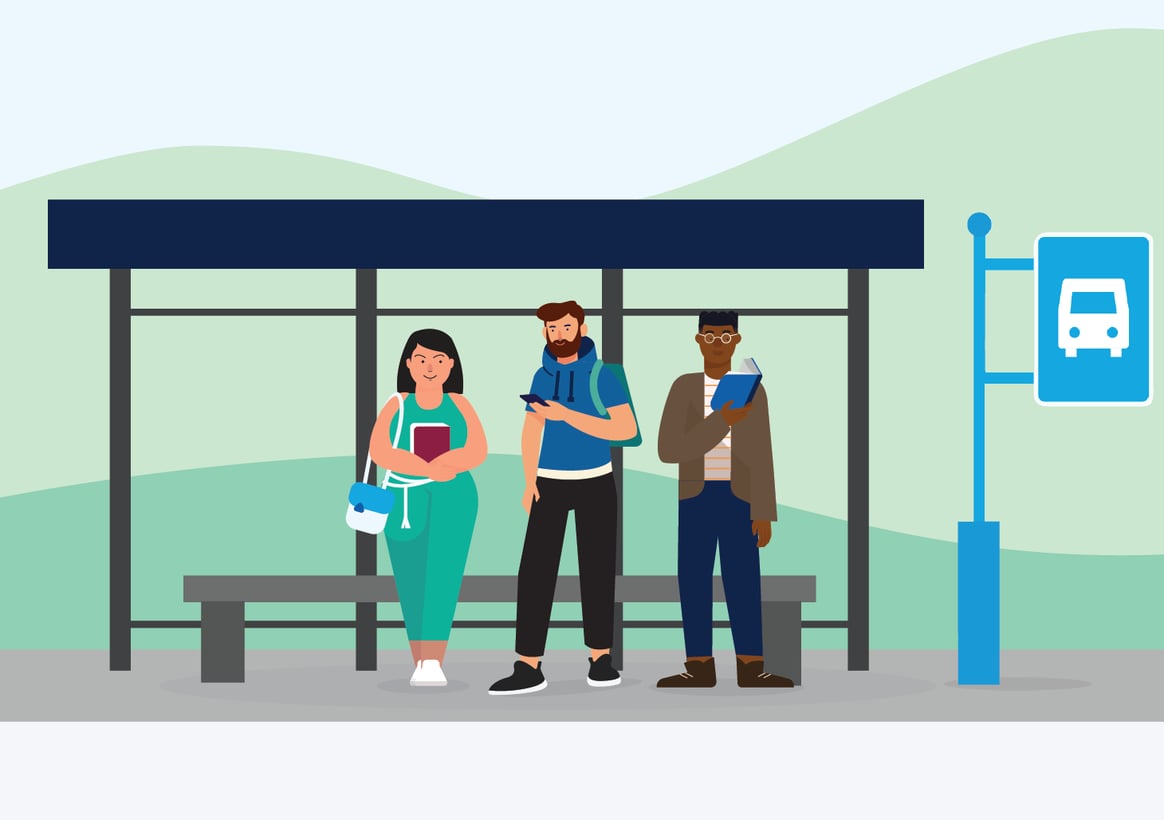Though colleges and universities have many strategies available to them to help students finish degrees — counseling resources, tutoring services, financial aid — one of the biggest barriers to students finishing school is as simple as it is frustrating: no easy or affordable way to get to and from school, as recently reported in the Washington Post.
With this in mind, many schools are enhancing their transportation offering through partnerships with local transit agencies, TransitTech companies like Via, or both, and trying everything from subsidized transit passes to dedicated on-campus transportation services. For some students — particularly low-income students — these efforts may be the difference between getting a degree and leaving school.
Costly transportation hurts already-disadvantaged students more than their peers.
Mobility challenges are more likely to affect students from low-income households, as well as students who identify as people of color. Among dozens of factors that hinder college completion, lack of transportation can be just as impactful as costly tuition, as found in a 2021 study of students at 2- and 4-year public colleges.
And a separate analysis of living expenses across both public and private colleges found that students can spend as much as 17% of their entire college budget on transportation, which surpasses the costs of books and educational supplies and almost matches food expenses. This trend is most salient among two-year community college students, a majority of whom live off-campus. In the 2021-22 school year, the study’s authors anticipate that they will spend an average of $1,840 on transportation — a higher amount than their counterparts at public and private four-year colleges, who often have the option to live on campus.
There are a few primary factors that make transportation a barrier for students, as found in a 2018 study:
- unaffordable transit costs;
- lack of available routes or schedules that fit students’ needs;
- the long walking distance to transit stops;
- lengthy travel time and unreliable services.
To fix these myriad mobility challenges, the study suggests a few types of transportation programs that colleges or cities could invest in, including “discounted or free transit passes, shuttle or vanpool programs” and even “partnerships” with companies offering on-demand transit, in order to provide services that best fit students' unique traveling needs.
Leveraging local public transit.
 Some colleges and universities are already taking these kinds of actions to respond. Some, like Portland State University in Oregon, and American University in Washington, D.C., have collaborated with the local transit agency for discounted unlimited transit passes for buses or subways. Community colleges like Chattanooga State, in Tennessee, have leveraged federal pandemic relief funds to provide all students and college employees with free bus rides through August 2022.
Some colleges and universities are already taking these kinds of actions to respond. Some, like Portland State University in Oregon, and American University in Washington, D.C., have collaborated with the local transit agency for discounted unlimited transit passes for buses or subways. Community colleges like Chattanooga State, in Tennessee, have leveraged federal pandemic relief funds to provide all students and college employees with free bus rides through August 2022.
“If the service was no longer available, I wouldn't have a ride to school or work.” — A student rider of Valdosta On-Demand. Schools like Georgia Military College and Wiregrass Georgia Technical College, both in Valdosta, Georgia, are working with local authorities to give their students access to a new form of mobility: on-demand microtransit. Both schools have purchased passcodes to give students free on-demand rides on the Via-powered Valdosta On-Demand service. Students can book a trip according to their own schedules, to wherever they need to go within the county limit, all by mobile app or by calling a dedicated phone line. It only takes students 1-2 minutes to walk to the pickup stops, making this transit mode especially convenient for those who are not living within the catchment area of fixed-route services.
Students formerly without transportation now have a reliable way to get to campus, improving their chances of completing a degree or certification. As Scott Matheson, the Mayor of Valdosta, observed, “If you have the best health care system or a great technical college that offers you that better life, if you can't get there you actually have nothing. Valdosta On-Demand is going to drop those barriers and is going to get you.” Via survey data also indicates that a high percentage of overall Valdosta On-Demand trips are for educational purposes.
For 10% of all Valdosta On-Demand riders, their most frequent use of the service is to go to and from schools. Some students reported Valdosta On Demand as their only viable transportation option: “If the service was no longer available, I wouldn't have a ride to school or work,” reported one student rider.
Dedicated on-campus transportation.
 A few other schools, many located where there are fewer existing transit resources — particularly for late-night travel — have built their own transportation services. Northwestern University upgraded its existing Safe Ride program by integrating technology-enabled services so that their services are highly adaptable to students’ needs and schedules.
A few other schools, many located where there are fewer existing transit resources — particularly for late-night travel — have built their own transportation services. Northwestern University upgraded its existing Safe Ride program by integrating technology-enabled services so that their services are highly adaptable to students’ needs and schedules.
The takeaway.
With a reliable way of transportation to travel on and beyond campus, students can get to class on time, get to campus jobs reliably, and stay late at the library without worrying about the lack of transportation to go home. Students who have easier and more affordable mobility options are more likely to keep on track with their degrees and earn a certificate (or degree).




